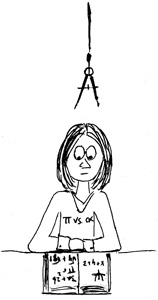Mathochism: Calling in the experts
One woman’s attempt to revisit the math that plagued her in school. But can determination make up for 25 years of math neglect?
 Math students at my community college are required to put in two hours at the math lab each week.
Math students at my community college are required to put in two hours at the math lab each week.
The lab, like most spaces in the warren-like bungalow known as the Math Complex, has no windows. It also has the same enclosed smell and suicide-inducing lighting as the classroom where I take pre-algebra two nights a week.
This, combined with the noise of students galumphing in and out, or chatting loudly to each other to drown out the humming fluorescents and shuddering AC, makes the lab a less than pleasant place to study.
I put in my first math lab session on Friday. Even with my iPod on at full blast, I found it difficult to focus on my homework over the noise. It was slow going, particularly since I have the hand-writing of a seriously sleep-deprived medical professional unless I really concentrate.
About an hour and a half into my work, I was getting smug. Least Common Multiples? In your face! Greatest Common Factors? Talk to the hand!
Then it happened. Problem 17.
On its face, it seemed simple enough: Find the GCF for 4600 and 7250. Having just whipped through a number of similar problems, I figured it was cake. I set about factoring out the primes. Then I set up the problem, and got 1150. But when I checked my result, I knew I was wrong.
I spent another 30 minutes trying to figure out what I did wrong. There are tutors in the lab, but they were all busy and had long waiting lists. Then the lab closed, so I had to pack up and go.
Once I got home, I was a woman obsessed. I went over the problem again and again and again. 1150. 1150. 1150. Then it occurred to me: maybe this was a trick question. The dapper professor — who has a strong Puckish streak — had mentioned that some operations were undefined. Could this be the case here?
I recently reconnected with an old friend from high school, and she is now married to a mathematician. This guy is not just any old mathematician, either. He works for a military think tank, and often travels to participate in war games. If I could rely on anyone to calculate the best way to intercept a missile from Kim Jong Il, it would be this man.
I was a bit embarrassed to bug this man with such a simple math question, but I also knew he teaches occasionally, and thought perhaps he would welcome a break from missile trajectories.
I e-mailed him with my question, and he was very kind; he answered immediately. The problem, though, with asking a professional mathematician for help with a simple math question is that you are going to get a complicated professional math answer.
His reply was absolutely crawling with letters instead of numbers. I am not quite up to letters yet; the dreaded letters are waiting for me in Algebra I. There were enough numbers in his reply, however, for me to realize this was not a trick question, and that my dapper professor was not testing me. Furthermore, his letter-filled solution told me I had been multiplying too many numbers. His explanation as to why I was multiplying too many numbers was still confusing.
I went back to the textbook hoping for an answer; no dice. Then I looked at my notes, and finally understood. I had made a very simple mistake.
But it is often the simplest mistakes that screw things up, in math and in life.
The whole experience was one of those Occam’s Razor moments, where I was looking for the most complicated solution instead of the simplest one. And while I was suspecting my professor of math trickery, I was ignoring one of the first lessons he taught me: if you stay on the straightest path, you will get to your destination. If you stray, you will get lost in the wilderness.
The GCF for 4600 and 7250, by the way, is 50.
All text copyrighted by A.K. Whitney, and cannot be used without permission.